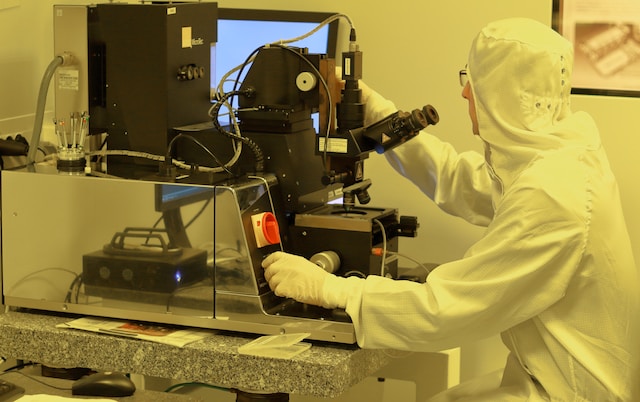Nanotechnology is revolutionizing the world we live in, especially when it comes to medicine and healthcare. The incredible potential of nanotechnology in these fields cannot be overstated. Imagine microscopic devices working within your body to detect diseases before they even manifest symptoms or delivering medication directly to diseased cells without harming healthy ones. This may sound like science fiction, but it’s becoming a reality thanks to nanotechnology. In this article, we’ll explore the exciting applications of nanotechnology in medicine and healthcare, as well as the challenges that come with implementing such advanced technology.
What is nanotechnology?
Nanotechnology involves the manipulation of matter on an incredibly small scale, at the nanometer level. To put this in perspective, one nanometer is one billionth of a meter! Scientists use tools and techniques to create and manipulate materials at this level, which can have unique properties that differ from their macroscopic counterparts.
One fascinating aspect of nanotechnology is that it has applications across many different fields. In medicine and healthcare, scientists are exploring how these tiny particles can be used to improve patient outcomes. For example, nanoparticles could be designed to deliver medication straight to diseased cells or tissues without harming healthy ones.
However, working with such small particles also presents challenges. Researchers need specialized equipment and expertise to manipulate them effectively. They must also consider potential health risks associated with exposure to nanoparticles.
Despite these challenges, the possibilities for nanotechnology in medicine and healthcare are truly exciting. With further research and advancements in technology, we may see more innovative treatments for diseases that were once thought incurable.
The potential applications of nanotechnology in medicine and healthcare
Nanotechnology has the potential to revolutionize medicine and healthcare in numerous ways. One of the most exciting applications is the development of nanorobots, which can be programmed to enter cells or tissues and carry out targeted therapies or diagnostic tests.
Another promising area is drug delivery, where nanoparticles can be designed to deliver drugs directly to specific cells or organs, potentially reducing side effects and increasing effectiveness. Nanoparticles could also be used for imaging purposes, allowing doctors to detect diseases earlier and more accurately.
Nanotechnology could also play a role in tissue engineering, with scientists using nanoscale materials as scaffolds for growing replacement tissues or organs. This could have tremendous implications for patients awaiting transplants.
Furthermore, nanotechnology could improve medical devices such as implants by making them smaller, more efficient and longer-lasting. It may even enable entirely new types of devices that were previously impossible due to size constraints.
The potential applications of nanotechnology in medicine are vast and varied. While there are still challenges ahead in terms of safety and regulatory approval, it’s clear that this technology has enormous promise for improving human health outcomes.
The challenges of implementing nanotechnology in medicine and healthcare
Despite the incredible potential of nanotechnology in medicine and healthcare, there are several challenges that must be addressed before it can become widely implemented. One major challenge is the issue of toxicity. Nanoparticles can potentially be toxic to living cells, leading to unintended consequences for patients.
Another challenge is ensuring the safety and efficacy of nanoparticles once they have been introduced into the body. It can be difficult to predict how nanoparticles will behave once inside a complex biological system like the human body, making it challenging to assess their effectiveness.
Regulatory approval is also a significant challenge for implementing nanotechnology in medicine and healthcare. The development process for new medical technologies can take years or even decades, requiring extensive testing and evaluation before any products can reach consumers.
Cost is another major obstacle to widespread implementation of nanotechnology in healthcare. Developing these advanced technologies requires significant investment, which may make them prohibitively expensive for many hospitals and clinics.
Despite these challenges, researchers remain optimistic about the potential benefits that nanotechnology could bring to medicine and healthcare if these obstacles are overcome. Through continued research and innovation, we may one day see nanoparticle-based treatments become commonplace in hospitals around the world.
The future of nanotechnology in medicine and healthcare
The potential of nanotechnology in medicine and healthcare is vast, and the future looks bright. In the coming years, we can expect to see more advanced diagnostic tools that use nanoparticles to detect diseases at earlier stages. These particles can also be used as targeted drug delivery systems, reducing the number of side effects associated with traditional treatments.
Furthermore, advancements in nanotechnology will lead to better imaging techniques for medical professionals. Nanoparticles could help create clearer images of organs and tissues, improving patient outcomes by enabling doctors to make better-informed decisions about treatment plans.
Another exciting development is the potential for nanobots – tiny robots made from nanoparticles – that could target specific cells or areas within our bodies. This technology would allow for precise surgery on a microscopic level without damaging surrounding tissue.
However, there are still significant challenges to overcome before these technologies become widely available. The cost of producing nanoparticles remains high; regulatory issues may arise around their use in humans; and ensuring their safety over time requires ongoing research efforts.
While there are hurdles yet to clear before widespread adoption occurs, the potential benefits of nanotechnology in medicine and healthcare are vast. As researchers continue to push boundaries and explore new applications for this field’s innovations , we can only anticipate an even more transformative impact on human health in the future!
Conclusion
Nanotechnology has immense potential in revolutionizing the world of medicine and healthcare. It promises to provide us with new tools and techniques for diagnosing and treating diseases that were once considered incurable. From targeted drug delivery systems to tissue engineering, the possibilities are endless.
However, it is important to note that implementing nanotechnology in medicine also comes with significant challenges such as toxicity concerns, regulatory hurdles, and ethical considerations. Therefore it is crucial for researchers, policymakers and stakeholders to work together towards addressing these challenges.
As we move forward into a future where technology continues to improve at an unprecedented pace, we can be sure that nanotechnology will continue to play a vital role in shaping the healthcare industry of tomorrow.




